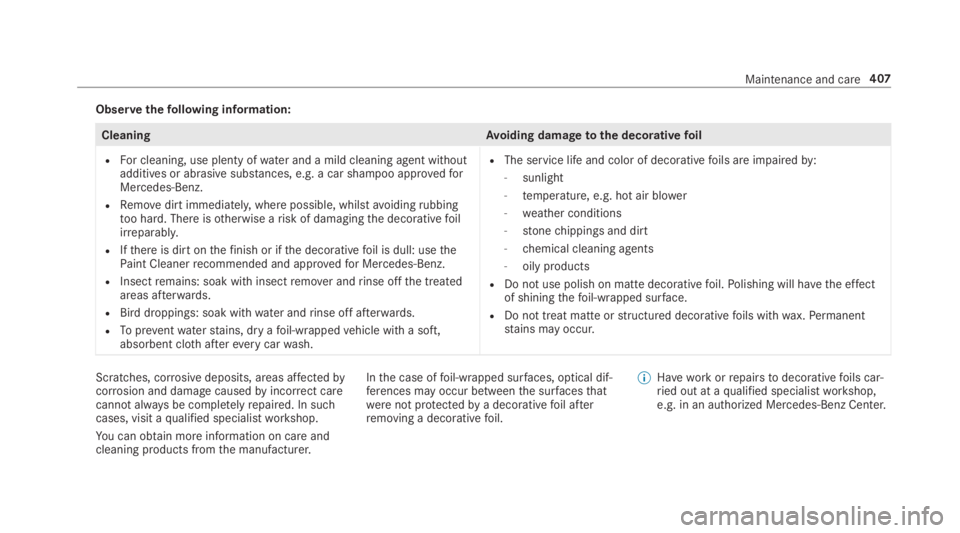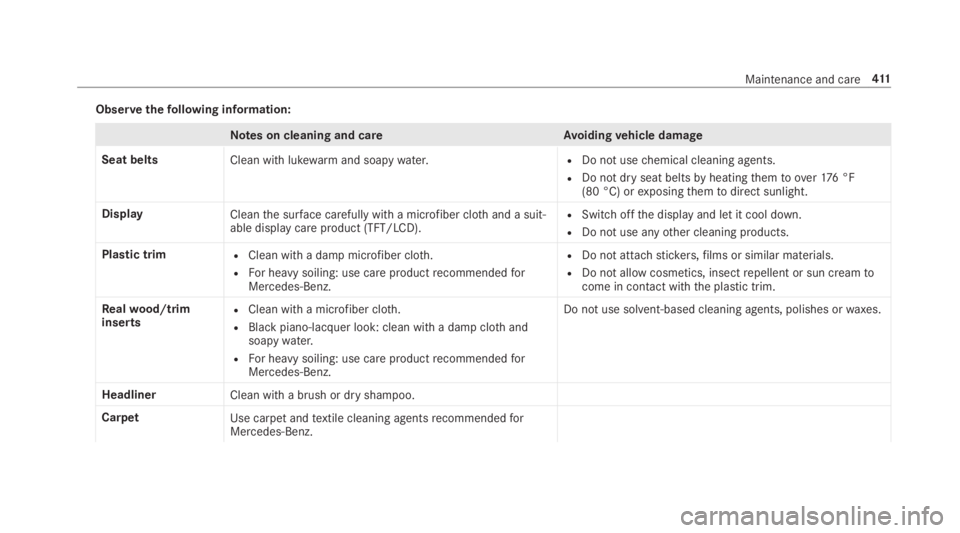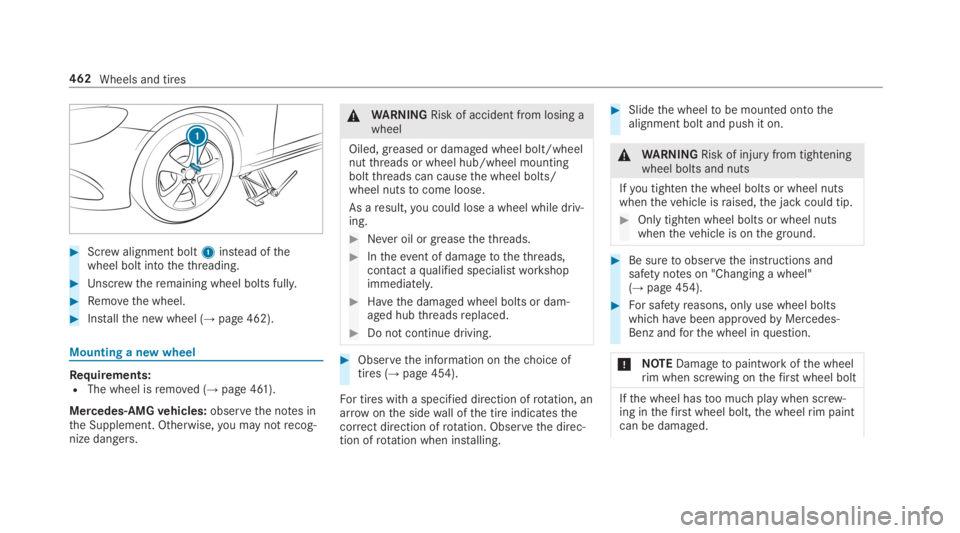2019 MERCEDES-BENZ S CLASS oil
[x] Cancel search: oilPage 409 of 578

Observethefollowing information:
CleaningAvoiding damagetothe decorativefoil
RFor cleaning, use plenty ofwater and a mild cleaning agent withoutadditives or abrasivesubstances, e.g. a car shampoo approvedforMercedes-Benz.
RRemovedirt immediately, where possible, whilstavoidingrubbingtoo hard. There isotherwise arisk of damagingthe decorativefoilirreparably.
RIfthere is dirt onthefinish or ifthe decorativefoil is dull: usethePaint Cleanerrecommended and approvedfor Mercedes-Benz.
RInsectremains: soak with insectremover andrinse offthe treatedareas afterwards.
RBird droppings: soak withwater andrinse off afterwards.
RTopreventwaterstains, dry afoil-wrappedvehicle with a soft,absorbent clothaftereverycarwash.
RThe service life and color of decorativefoils are impairedby:
-sunlight
-temperature, e.g. hot air blower
-weather conditions
-stonechippings and dirt
-chemical cleaning agents
-oily products
RDo not use polish on matte decorativefoil.Polishing will havethe effectof shiningthefoil-wrapped surface.
RDo not treat matte orstructured decorativefoils withwax.Permanentstains may occur.
Scratches, corrosive deposits, areas affectedbycorrosion and damage causedbyincorrect carecannot alwaysbe completelyrepaired. In suchcases, visit aqualified specialistworkshop.
You can obtain more information on care andcleaning products fromthe manufacturer.
Inthe case offoil-wrapped surfaces, optical dif‐ferences may occur betweenthe surfacesthatwerenot protectedbya decorativefoil afterremoving a decorativefoil.
%Haveworkorrepairstodecorativefoils car‐ried out at aqualified specialistworkshop,e.g. in an authorized Mercedes-Benz Center.
Maintenance and care407
Page 413 of 578

Observethefollowing information:
Notes on cleaning and careAvoidingvehicle damage
Seat beltsClean with lukewarmand soapywater.RDo not usechemical cleaning agents.
RDo not dry seat beltsbyheatingthemtoover176 °F(80 °C) orexposingthemtodirect sunlight.
DisplayCleanthe surface carefully witha microfiber clothand a suit‐able display care product (TFT/LCD).RSwitchoffthe display and let it cool down.
RDo not use anyother cleaning products.
Plastic trimRClean with a damp microfiber cloth.
RFor heavy soiling: use care productrecommendedforMercedes-Benz.
RDo not attachstickers,films or similar materials.
RDo not allow cosmetics, insectrepellent or sun creamtocome in contact with the plastic trim.
Realwood/triminsertsRClean with a microfiber cloth.
RBlackpiano-lacquer look: clean with a damp clothandsoapywater.
RFor heavy soiling: use care productrecommendedforMercedes-Benz.
Do not use solvent-based cleaning agents, polishes orwaxes.
HeadlinerClean with a brush or dry shampoo.
CarpetUse carpet andtextile cleaning agentsrecommendedforMercedes-Benz.
Maintenance and care411
Page 454 of 578

UniformTireQuality GradingStandards:auniformstandardtogradethequality of tireswithregardtotreadquality,tire traction andtemperaturecharacteristics. Thequality gradingassessment is madebythe manufacturerfollow‐ing specifications fromtheU.S. government. Thequalitygrade of a tire is imprinted onthe sidewall ofthe tire.
Recommended tire pressure:therecommen‐ded tire pressure isthe tire pressure specifiedforthe tires mountedtothevehicle atthefac‐tory.
The tire and informationtable containstherec‐ommended tire pressuresfor cold tires,the max‐imum permissible load andthe maximum per‐missiblevehicle speed.
The tire pressuretable containstherecommen‐ded tire pressuresfor cold tires undervariousoperating conditions, i.e. loading and/or speedofthevehicle.
Increasedvehicleweight duetooptionalequipment:the combinedweight of allstandardand optional equipmentavailableforthevehicle,
regardless of whether it is actually installed onthevehicle or not.
Rim:the part ofthe wheel on whichthe tire isinstalled.
GAWR (Gross AxleWeightRating):the GAWRisthe maximum permissible axle load. Theactual load on an axle must neverexceedthegrossaxleweightrating. The gross axleweightrating can befound onthevehicle identificationplate onthe B‑pillar onthe driver's side.
Speedrating:the speedrating is partofthe tireidentification. It specifiesthe speedrangeforwhich a tire is approved.
GVW (GrossVehicleWeight):the grossvehicleweight comprisestheweight ofthevehicleincluding fuel,tools,the spare wheel, accesso‐ries installed, occupants, luggage andthe trailerdrawbar noseweight, if applicable. Thegrossvehicleweight must notexceedthe grossvehicleweightratingGVWR as specified onthevehicleidentification plate onthe B‑pillar onthe driver'sside.
GVWR (GrossVehicleWeightRating):theGVWR isthe maximum permitted grossweight
ofthe fully ladenvehicle (weight ofthevehicleincluding all accessories, occupants, fuel, lug‐gageandthe trailer drawbar noseweight if appli‐cable). Thegrossvehicleweightrating is speci‐fied onthevehicle identification plate ontheB‑pillar onthe driver's side.
Maximumweight ofthe ladenvehicle:themaximumweight isthe sum ofthe curbweightofthevehicle,theweight ofthe accessories,themaximum load andtheweight of optional equip‐ment installed atthefactory.
Kilopascal (kPa):metric unitfor tire pressure.6.9 kPa correspondsto1 psi. Another unitfortire pressureis bar.100 kilopascal (kPa) equals1 bar.
Load index:in additiontothe load-bearingindex,the load index may also be imprinted onthe sidewall ofthe tire. This specifiesthe load-bearing capacity ofthe tire more precisely.
Curbweight:theweight of avehicle withstand‐ard equipment includingthe maximum capacityof fuel, oil and coolant. It also includesthe airconditioning system and optional equipment if
452Wheels and tires
Page 459 of 578

Thewear patterns onthe front andrear wheelsdiffer:
RFront wheelswear more onthe shoulder ofthe tire
RRear wheelswear more inthe center ofthetire
Onvehiclesthat havethe same size front andrear wheels,rotatethe wheels accordingtotheintervals inthe tire manufacturer'swarrantybook inyourvehicle documents. Ifthis is notavailable,rotatethe tiresevery3,000to6,000 miles (5,000to10,000 km),depending onthewear. Ensurethatthe directionofrotation is maintained.
It is imperativetoobservethe instructions andsafety notes on "Changing a wheel" when doingso Preparingthevehiclefor a wheelchange(→page 458).
Notes onstoring wheels
Whenstoring wheels, observethefollowingnotes:
RAfterremoving wheels,storethem in a cool,dry and preferably dark place.
RProtectthe tires from contact withoil, greaseor fuel.
Overview ofthe tire-changetool kit
Apart from some country-specificvariants,vehi‐cles are not equipped with a tire-changetool kit.For more information on whichtire-changetoolsarerequired and approvedfor performing awheelchange onyourvehicle, consult aqualifiedspecialistworkshop.
Required tire-changetools may include,forexample:
RJack
RChock
RLug wrench
RAlignment bolt
The tire-changetool kit is located underthetrunkfloor.
1Ratchet
2Alignment bolt
3Jacking support
4Jack
5Lug wrench
6Foldingchock
Wheels and tires457
Page 464 of 578

#Screwalignment bolt1instead ofthewheel bolt intothethreading.
#Unscrewtheremaining wheel bolts fully.
#Removethe wheel.
#Installthe new wheel (→page 462).
Mounting a new wheel
Requirements:RThe wheel isremoved (→page 461).
Mercedes-AMGvehicles:observethe notes inthe Supplement. Otherwise,you may notrecog‐nize dangers.
&WARNINGRisk of accident from losing awheel
Oiled, greased or damaged wheel bolt/wheelnutthreads or wheel hub/wheel mountingboltthreads can causethe wheel bolts/wheel nutstocome loose.
As aresult,you could lose a wheel while driv‐ing.
#Never oil or greasethethreads.
#Intheevent of damagetothethreads,contact aqualified specialistworkshopimmediately.
#Havethe damaged wheel bolts or dam‐aged hubthreadsreplaced.
#Do not continue driving.
#Observethe information onthechoice oftires (→page 454).
For tires with a specified direction ofrotation, anarrowonthe sidewall ofthe tire indicatesthecorrect direction ofrotation. Observethe direc‐tion ofrotation when installing.
#Slidethe wheeltobe mounted ontothealignment bolt and push it on.
&WARNINGRisk of injuryfrom tighteningwheel bolts and nuts
Ifyou tightenthe wheel bolts or wheel nutswhenthevehicle israised,the jack could tip.
#Only tighten wheel bolts or wheel nutswhenthevehicle is onthe ground.
#Be suretoobservethe instructions andsafety notes on "Changing a wheel"(→page 454).
#For safetyreasons, onlyuse wheel boltswhich havebeen approvedbyMercedes-Benz andforthe wheel inquestion.
*NOTEDamagetopaintwork ofthe wheelrim when screwing onthefirst wheel bolt
Ifthe wheel hastoo much play when screw‐ing inthefirst wheel bolt,the wheelrim paintcan be damaged.
462Wheels and tires
Page 472 of 578

#Onlyfillthe fueltanktohalf full withunleadedregulargasoline andtop up assoon as possible with unleaded pre‐mium gradegasoline.
#Do not drive atthe maximum speed.
#Avoid sudden acceleration and enginespeedsover 3000rpm.
This mayreduce engine performance andincrease fuel consumption. Neverrefuel usinggasoline with a lower octane number.
Further information on fuel can befound:
Rat agasstation
Rat aqualified specialistworkshop
RUSA only:at http://www.mbusa.com
Information on additives ingasolineObservethe notes on operatingfluids(→page 468).
*NOTEDamagefrom use of unsuitableadditives
Even small amounts ofthe wrong additivemay leadtomalfunctions occurring.
#Only add cleaning additivesrecommen‐dedbyMercedes-Benztothe fuel.
Mercedes-Benzrecommendsthatyou use fuelbrandsthat haveadditives.
In some countries,the fuelavailable may nothavesufficient additives.Residue could build upinthe fuel injection system as aresult. Inthiscase, in consultation with an authorizedMercedes-Benz Center,the fuel may be mixedwiththe cleaning additiverecommendedbyMercedes-Benz. Be suretoobservethe notesand mixingratios specified onthe container.
Tank content and fuelreserveThetotal capacity ofthe fueltank mayvary,depending onthevehicle equipment.
ModelTotal capacity
All models21.1gal (80.0 liters)
ModelOf whichreserve
All models2.1gal (8.0 liters)
Engine oil
Notes on engine oilObservethe notes on operatingfluids(→page 468).
47 0Technical data
Page 473 of 578

*NOTEEngine damagecausedbyanincorrect oilfilter, incorrect oil or addi‐tives
#Do not use engine oils or oilfiltersotherthanthose which meetthe specifica‐tions necessaryforthe prescribedservice intervals.
#Do not alterthe engine oil or oilfilter inordertoachievelongerchange intervalsthan prescribed.
#Do not use additives.
#Havethe engine oilchanged aftertheprescribed intervals.
Mercedes-Benzrecommendsthatyou havetheoilchange carried out at aqualified specialistworkshop.
Further information on engine oil and oilfilters isavailable atthefollowing locations:
RInthe Mercedes-Benz SpecificationsforOperating Fluidsbyenteringthe designation:
-Athttp://bevo.mercedes-benz.com
-Inthe Mercedes-Benz BeVo app
Rat aqualified specialistworkshop
Quality and capacity of engine oil
MB-Freigabe or MB-Approval
SedanMB-Freigabe or MB-Approval
S 450 4MATIC229.5, 229.6
S 560 4MATIC229.52, 229.61
Long wheelbasevehiclesMB-Freigabe or MB-Approval
S 450 4MATIC
S 450
229.5, 229.6
Allother models 229.52, 229.61
Mercedes‑MaybachMB-Freigabe or MB-Approval
S 650 Mercedes-May‐bach229.5
S 560 4MATICMercedes-Maybach229.52, 229.61
Thefollowingvaluesrefertoan oilchange,includingthe oilfilter.
Capacity
SedanCapacity
S 450 4MATIC 6.9 US qt (6.5 liters)
S 560 4MATIC 9.5 US qt (9.0 liters)
Long wheelbasevehiclesCapacity
S 450 4MATIC
S 450
6.9 US qt (6.5 liters)
Allother models 9.5 US qt (9.0 liters)
Technical data471
Page 474 of 578

Mercedes‑MaybachCapacity
S 650 Mercedes-May‐bach11.1US qt(10.5 liters)
S 560 4MATICMercedes-Maybach9.5 US qt (9.0 liters)
Notes on brakefluid
Observethe notes on operatingfluids(→page 468).
&WARNINGRisk of an accident duetovapor pocketsforming inthe brake sys‐tem
The brakefluid constantly absorbs moisturefromthe air. This lowersthe boiling point ofthe brakefluid. Ifthe boiling point istoo low,vapor pockets mayforminthe brake systemwhenthe brakes are applied hard.
This causesthe braking effecttobeimpaired.
#Havethe brakefluidrenewed atthespecified intervals.
Havethe brakefluidregularlyreplaced at aqualified specialistworkshop.Only use brakefluid approvedbyMercedes-BenzaccordingtoMB-Freigabe or MB-Approval 331.0.
You can obtain further information on brakefluidinthefollowing places:
Rinthe Mercedes-Benz SpecificationsforOperating Fluids
-at http://bevo.mercedes-benz.com
-inthe Mercedes-Benz BeVo App
Rat aqualified specialistworkshop
Coolant
Notes on coolantObservethe notes on operatingfluids(→page 468).
&WARNING‑ Risk offireand injury fromantifreeze
If antifreeze comes into contact withhotcomponent parts inthe engine compart‐ment, it may ignite.
#Allowthe enginetocool down beforeadding antifreeze.
#Makesurethat no antifreeze spills outnexttothefiller opening.
#Thoroughly clean off any antifreezefrom component parts beforestartingthevehicle.
*NOTEDamagecausedbyincorrect cool‐ant
#Only add coolantthat has been pre‐mixed withtherequired antifreeze pro‐tection.
472Technical data